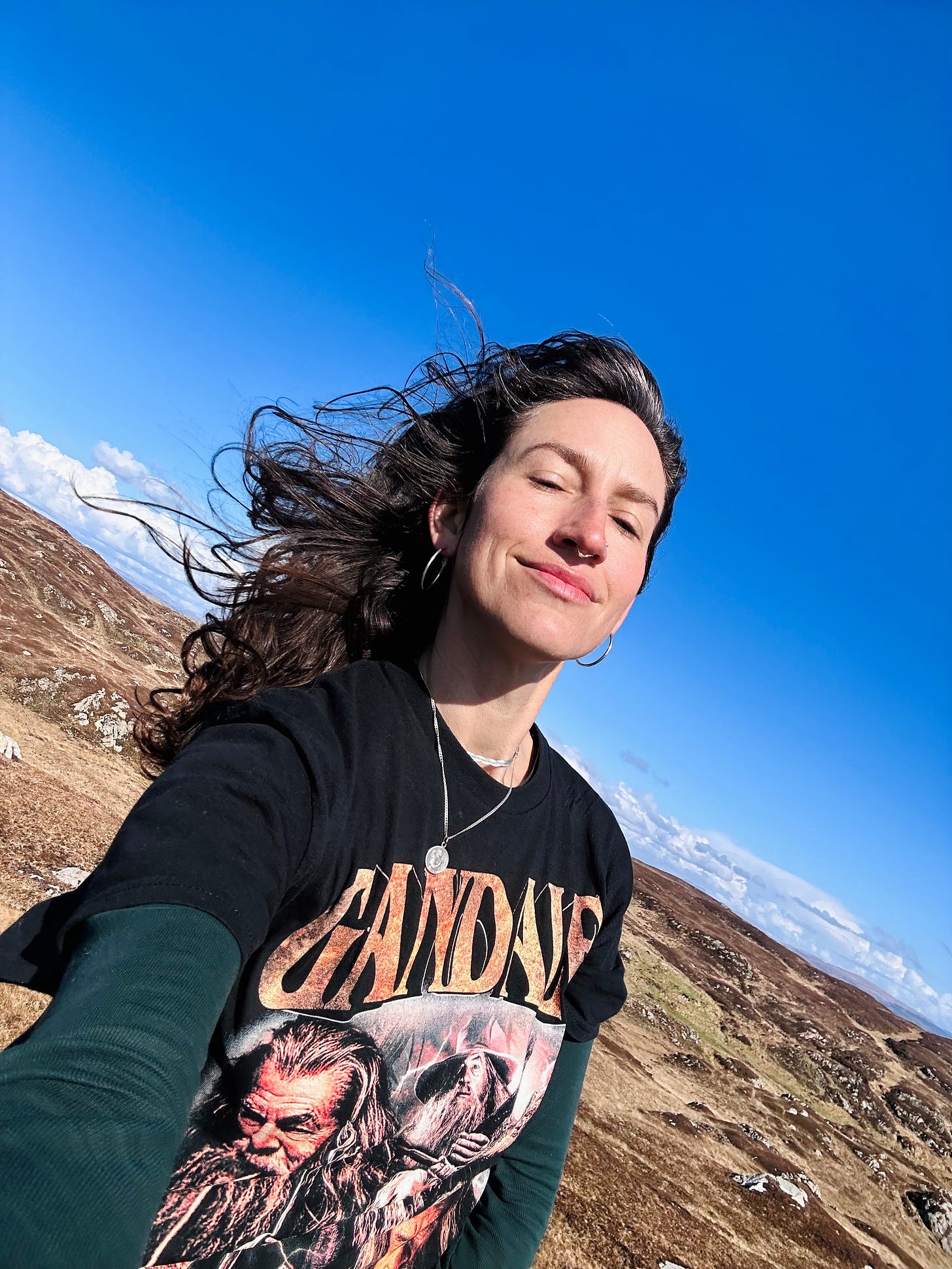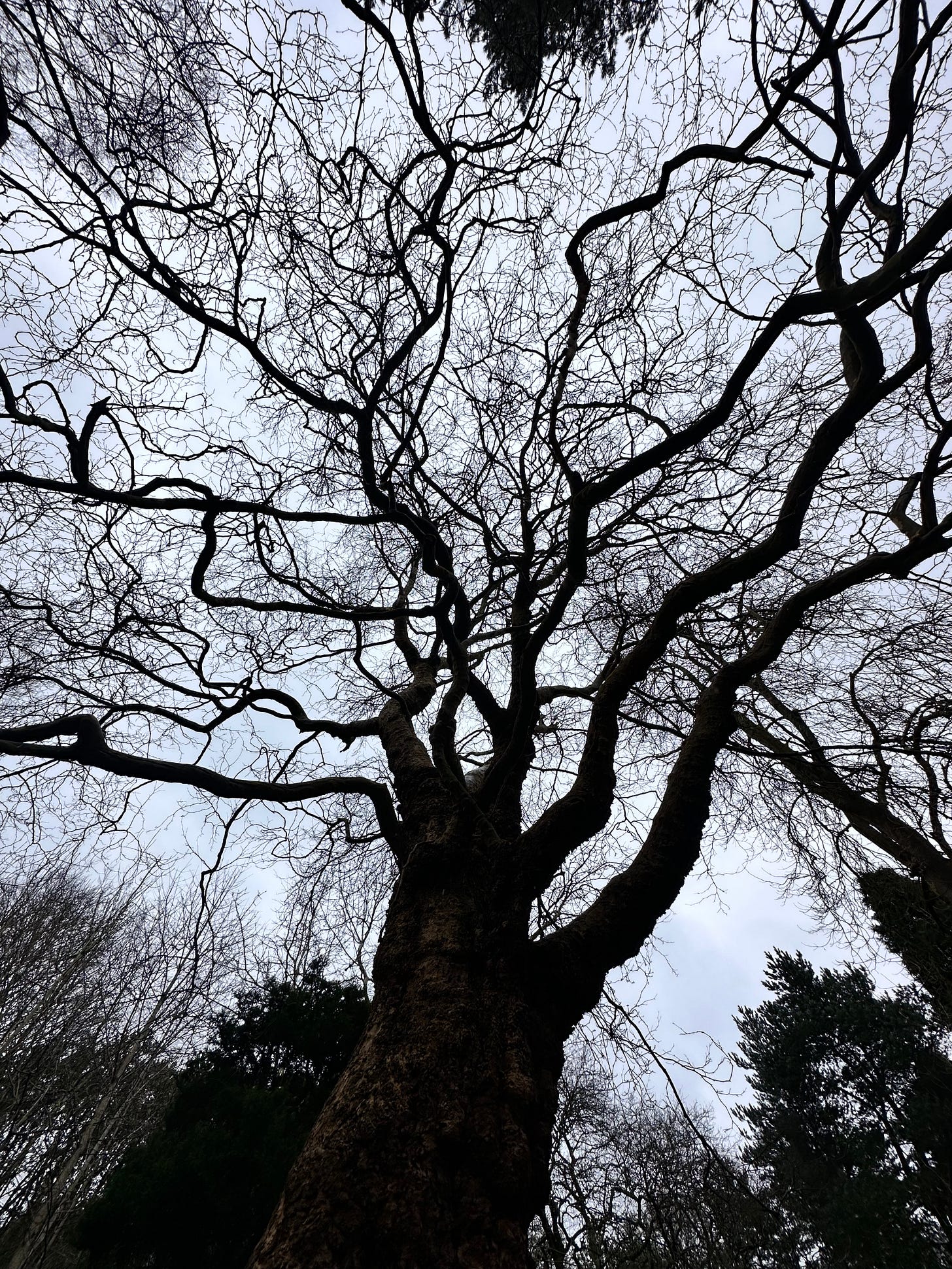In Chapter 6: The Old Forest, our Hobbits leave the Shire and—steering clear of the main road east for fear of the Black Riders—enter a dense and fabled wood that nearly swallows them up.
Relatable.
This month I got so turned around in there—sucked all the way down the Dingle to where all the Queerness comes. What’s felt aggravating is that I’ve spent more time in this Forest than in any other corner of Middle-earth. I’ve made a practice of passing through the tunnel and have learned to sense when I’m starting to come under its spell. I’ve learned how to breath in there, and surrender to the path its chosen for me, trusting that before nightfall I’ll shout out to no one until I hear the The Master’s song and feel his hands at the small of my back as he puts the trees to sleep and leads me up the hill to safety. But no Hand of Grace has come quite yet; I’ve had to use my claws.
The Old Forest, turns out, is like a formless mist I can smell, taste, hear, and feel, but when I try to dress it up in flesh and bone I run into some obstacles:
Language Barriers: Effective discourse for Chapter 6 wants the language of the trees—mycorrhizal whispers—and the subtle body, for which I don’t have alphabets.
Writing from Wide Open: I brought this Chapter with me to Iona1, a Holy island in Scotland’s Inner Hebrides. I thought writing would come easy with space away from home; I thought I’d maybe even stockpile some Chapters up for later. But Iona is a little smidge of earth suspended in a cloud of air and sea and sky. On Iona there are these little tufts of green on the tip tops of the rocky hills, like teets, where birds of prey land2. If you’re up on one when the wind dies down and you sit very still, you can just make out the angel choirs of Heaven, missives from behind the veil. How could I force myself back under when I was so high up? On Iona I counted only four trees, their whispers drowned in birdsong.
Lacking Context: I’ve been undecided on how much information to pull in from elsewhere in the Tolkien Legendarium because I don’t love the idea of spending your precious attention on stuff you could find on the Internet, but of course so much of the novel is wildly enhanced by a little backstory. This Chapter especially gets me wanting to talk about Yavanna and the full expression of her music.
Trying to talk through all three of these obstacles in one space keeps resulting in a gallumping clunker of a Frankenstein’s monster. So today I’m just going to work through number 3 and maybe we’ll come back around to number 1 and 2 if Tom’s house doesn’t beckon sooner.
With a little Middle-earth cosmology and history, we’ll see why the Old Forest is so righteously angry.
The Timeless Halls
Why a lot of us get sucked in to Tolkien’s Legendarium forever is that he wrote into being so thorough an alternate universe—with its own creation stories, cosmology, historiography, and more. There’s a lot we can pick up in a deep read of the Lord of the Rings, but to get the creation story you have to pop over to the The Silmarillion, an unfinished work by The Professor, published by his son, Christopher, five years after his death. Most of the creation story can be found in Chapter 1—The Ainulindalë—which is really worth a read even if you have no interest in seeing the whole book through. It reads a little like The Bible, but better. Point is, that’s where this context is coming from.
Let’s start zoomed in.
Think of Middle-earth as a continent on a planet called Arda. If it helps, you can think of Arda as Earth.
Think of Arda as a planet in the broader universe called Eä.
Think of Eä as being the physical realm of the universe within a boundless, formless eternity called the Timeless Halls. I guess you can think of that as Heaven, but hold that thought gently because it’s unclear who exactly goes there when they die.
All of it conceived by Eru Illúvatar, who you can think of as God, The Creator. Father of All. The One Alone.
In the beginning, before the creation of Eä, Eru created the Ainur, The Holy Ones. Think of the Ainur as the sub-creators of Eä. Like highly-skilled craftsmen working in an Atelier under the guidance of a Supreme Master.
From the Timeless Halls, Eru first teaches the Ainur the craft of Music, which they each possess their own unique expression of. So dope. Together they hone their skills and learn to harmonize with each other, until Eru gives the Ainur a vision of the world to come, and asks each of them to use their gift to make the vision incarnate. Manwë sang the sky and the winds; Ulmo sang the oceans, rains, rivers, and rills; Aulë sang the mountains and minerals and glistening gemstones; Varda—the Valar that Melkor feared most—sang the stars and celestial bodies. Yavanna sang the plants and trees, and to her they were precious and holy beyond measure.
When she first sang them to being, and tended to and watched over them, she couldn’t yet imagine death and destruction. She didn’t yet know that Men and Elves and Dwarves and Melkor and Sauron and their Armies, and even Hobbits would wield axes, saws, and fires on her children.
When Yavanna learns of what’s to come, and foresees the fate of her Forest, she is bereft. She pleads to Eru to do something about it. Pitying her, he creates the Ents—sentient tree-beings capable of learning the languages of other races—to help protect her sub-creation.
Fast Forward to the Third-Age
That was all many Ages ago. Let’s fast forward, back to the Old Forest as it is just before our four Hobbits attempt to cross it. Bordered in the east by the Barrow-downs, and in the west by the River Brandywine. The Withywindle Valley winding north-south through its center. The Withywindle River with water-lilies on its banks. An up, down, and underhill—the house of Goldberry and Tom Bombadill.
We wake up at Crickhollow at half-past four. It’s September 26, T.A. 3018, and the Hobbits are preparing to pass through the tunnel, crossing the threshold of the Shire and into a wilder place. Seeded by Yavana in the first Spring of Arda, what’s left of the Old Forest is a painful, shrunken remnant of a once mighty, rambling wood that long ago covered nearly all of Eriador, from the Blue Mountains in the west, to the Misty Mountains in the east.
What wasn’t scorched by Melkor in the 1st Age and Sauron in the 2nd Age was felled by the great men of Númenor to build their mighty ships. By the time a colony of curious Hobbits crossed the Brandywine to establish their settlement in the 3rd age (remember Gorhendad from last time?), just a dense and hostile fraction of the forest remained, and this they felled at the edges to make room and timber for their homes with many halls and windows. All around these pioneering Hobbits erected a Hedge—The High Hay—to keep their peace, and confine the ill-will of the injured wood.
The forest is angry.
Scorned by this new, false border between them and the rest of Creation, the trees come over and press themselves up against the Hedge. The Buckland Hobbits, in turn, cut down hundreds of trees and burn them in a Bonfire, forming a glade—the Bonfire Glade—where now no trees can grow.
From her pastures in the South of Valinor, Yavanna, their mother, weeps.
“The hobbits came and cut down hundreds of trees, and made a great bonfire in the Forest, and burned all the ground in a long strip east of the Hedge. After that the trees gave up the attack, but they became very unfriendly. There is still a wide bare space not far inside where the bonfire was made.” pg 145, Fellowship of the Ring
There are no Ents left in the Old Forest now, but there are Huorons. Huorons, like Ents, can communicate with each other but don’t have the capacity—or perhaps the desire—to learn the languages of other, nonprimordial Races. They’re transitory and sentient, but not fully awake. We can think of Huorons and Ents existing together on a spectrum, where some Huorons grow more sentient and Ent-ish over time, and some at the Ent-end slide back toward the Huoron-end.
All of them remember: the sawing and hacking and burning and screaming now coursing through their phloem and xylem and sapwood and through to the tips of their rootcaps, and back and forth from one tree to another. All of them connected in a network of resentment, grief, vengeance, and anger.
The angriest of all is Old Man Willow3.
Just after 6 on September 26, the Hobbits have packed their ponies. The morning is silver, the air is clear, the leaves and twigs are glistening with cold dew. In a moment they’ll be under his spell.
In 563 AD St. Columba, or Columcille, sets off from Ireland to establish a monastery on Iona, exorcise a demon from a milk pail, defeat the Loch Ness Monster, restore a severed head to its body, blind a monk as punishment for spying on him through a peep hole, spread the Good Word, etc.
The birds bring their fish and crabs up there to eat, and leave their droppings, so that each of the little tufts are a fertile and fecund microbiome that bird-folk can peer into to get a sense of who’s been eating what and where.
In the next Chapter, Tom will tell the Hobbits more about Old Man Willow: “His heart was rotten, but his strength was green; and he was cunning, and a master of winds, and his song and thought ran through the woods on both sides of the river. His grey thirsty spirit drew power out of the earth and spread like fine root-threads in the ground, and invisible twig fingers in the air, till it had under its dominion nearly all the trees of the Forest from the Hedge to the Downs.” pg 170






this was quite the ride! great work as always!